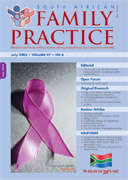High school students’ attitudes, practices and knowledge of contraception in Jozini, KwaZulu-Natal.
Abstract
This study assessed the knowledge, attitudes and practices of contraception and sexual awareness amongst high school pupils in rural KwaZulu-Natal. Two hundred males and 200 females from five high schools in the Jozini district completed confidential, self-administered questionnaires in isiZulu. Almost two-thirds (61%) of the males and only 34.5% of the females indicated that they had girlfriends or boyfriends. Many more males (61.6%) than females (27.8%) indicated that they had engaged in sexual intercourse. The average age of first sexual intercourse was 15.4 years for the males and 16.4 years for the females. The most common contraceptive used among the males was a condom (81.4%) and among females it was the injection (65.4%). There was a high rate of unprotected sexual activity among the respondents, with 75.2% of the males and 61.5% of the females indicating that they had had sex without contraception. Most respondents received contraceptive information from the media. The preferred source of information was a doctor (45% male, 36.5% female). Only 29.1% of the males and 26.4% of the females indicated that their parents had discussed contraception with them. The high level of sexual activity and low contraceptive use put these adolescents at risk of pregnancy and STD infections. This study indicates that adolescents want to receive information on sexuality and contraception from their doctors. (SA Fam Pract 2005;47(6): 54-57)
Published
2005-07-01
Issue
Section
Original Research
By submitting manuscripts to SAFP, authors of original articles are assigning copyright to the South African Academy of Family Physicians. Copyright of review articles are assigned to the Publisher, Medpharm Publications (Pty) Ltd, unless otherwise specified. Authors may use their own work after publication without written permission, provided they acknowledge the original source. Individuals and academic institutions may freely copy and distribute articles published in SAFP for educational and research purposes without obtaining permission.

